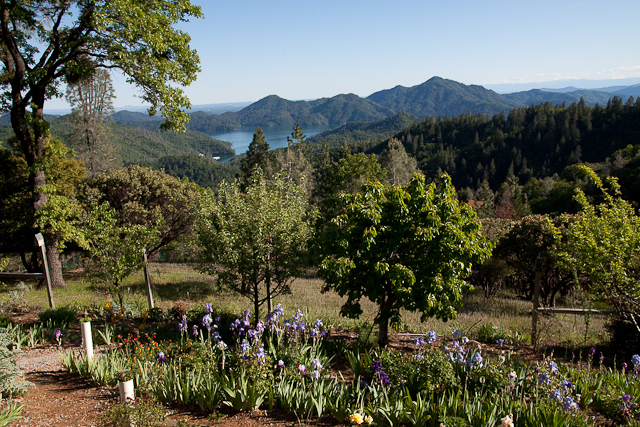| |
Nancy's garden
Mountain garden (2,000 feet in elevation) on a steep hill, north of Redding, Lakehead area, with a special deer-resistant garden in front of the house.

PHOTO GALLERY WITH ALL PHOTOS OF NANCY'S GARDEN
Nan’s Mountain Garden
My mountainside garden has been over 20 years in its evolution. When we bought the house and property in 1988, the yard was almost completely wild, with the exception of the deer-proof oleander lining the driveway and juniper across the front of the house. My first gardening act was to put in rhododendrons as they were supposed to also be deer-proof. No such luck! The almost-tame dear on our mountain ate them down to thumb-sized twigs.
On to Plan B. My loving husband, (no gardener himself, but a sympathetic soul) had a 6’ field fence erected around the area I wanted to develop. We used cedar posts cemented into the ground, and to beautify them, I’ve gradually added small bird houses to their tops. (I soon learned that squirrels use them to bank acorns, and in order to have any room for birds to nest, I have to take them down and empty them regularly.)
I maintain planting beds outside the fence to test plants that are said to be deer-proof. In them I’ve found the following plants to be sure-fire bets. The deer leave them alone (after tasting ALL new plantsas they will always do): Holly, oleander, juniper, the natives like wild bleeding-heart (Dicentra Formosa), ceonothus, Flannel bush (Fremontrodendron), and wild lupine. Also safe are daffodils, squil (Scilla siverica), naked ladies (Amaryllis belladonna), Arum italicum, bush peonies, Rosemary, Spanish lavender, Russian sage, and most coreopsis.
Plants that survive over the long run, but are eaten in the fall when browse is scarce are English lavender, Shasta daisy, Acantha, Japanese anemonies, ajuga, Grevellea ‘Noellii’, ribbon grass (miscanthus sinensis), Rue, (Ruta graveolans),Verbena bonesari, Jerusalem sage (Phlomis), vinca, blue fescue, Sweet Woodruff, Campanula, some artemesia, and the LEAVES of iris (the flowers never survive).
Over the first few years on the mountain, I concentrated on digging out roots of Manzanita, Toyon, wild Viburnum, and baby oak and pine trees while I moved dirt and rocks around to form pathways and terraces. I tend to be an eclectic gardener – there aren’t many plants I don’t love and won’t try if they look good, smell good, or give me food. My abiding philosophy has become, “They’ll live or they’ll die.” And if they die, I get to try something new. My main source of plants and lore has been the great people at Turtle Bay Arboretum. I have volunteered at the nursery for 12 years and value the gardeners I meet there. “Dirt People” are real, unpretentious, and caring – besides being fun, full of information, and willing to share plants.
The favorite parts of my present garden are, besides my green house where I love to play, the iris and dogwood in the spring, the roses after that, and always my practical side loves my food plants. I enjoy picking my own asparagus, artichokes, cherries, apricots, boysenberries, peaches, plums, figs, pears, and apples. And this year I’ve added a raised veggie bed where there are tomatoes, eggplant, one Jalapeno pepper for my dearest husband, Swiss chard, shallots, and garlic. I also value my herb bed to add flavor to my cooking. Because I’m into my 7th decade, I’ve kept my semi-dwarf fruit trees pruned down to my size with my trusty electric sawzall so there is no tree climbing done. Fruit trees are just as happy short, and still give plenty of fruit for two people to use and share. An extensive drip irrigation system I’ve designed and re-designed over the years, along with an expensive, but vital electric timer system keeps the entire garden green without too much trouble on my part.
I’ve gradually found a micro climate on the hillside where roses will do well. They need full sun all day to bloom well, so they go on the southern slope. On the west, I have my herbs and an assorted collection of things that will take hot sun and rocky soil. The east slope is used for my dogwood collection and the shade lovers like camellias, azaleas, rhododendrons and tree peony. My fish ponds are also in the shade, under the dogwoods. This makes for less algae growth, but also fewer flowers on the water lilies. The fish seem happy, so it’s OK.
I make extensive use of ground covers as I do hate weeding, and pesky pop-weed, cursed oxalis, and spurge just keep on keeping on. There are great ground covers for anywhere in your garden. In the shade I love campanula and Sweet Woodruff, bugle in part shade, and in the sunny areas I love creeping Jenny, Snow-in-Summer, thymes of all kinds, and tiny-leafed Veronicas.
I won’t try and name all my plants; my database holds hundreds! The pictures will give you a hint at my passion for both color and practical food plants, and show you my “play pen” out behind the garage where I propagate and grow my mini-nursery of plants I just can’t throw away. Some are seedlings, some are cuttings, and some are orphans from friends. All are loved. My friends find this trait handy when they need a few fill-in plants in their gardens.
Enjoy the photo gallery Barb has provided for you, and consider adding your garden to the site.
Nancy
|
|